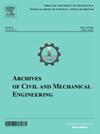Influence of buttering layers on the microstructural evolution and mechanical behavior of Incoloy 800HT and P91 steel welded joint
Abstract
This study delves into the microstructure and mechanical properties of a dissimilar metal weld (DMW) joining Incoloy 800HT and P91 steel. The P91 was buttered with Inconel 82 (ERNiCr-3) filler layers, and the final DMW weld was fabricated using Inconel 617 (ERNiCrCoMo-1) filler. Weld interface regions were characterized using electron backscatter diffraction (EBSD) and scanning electron microscopy. EBSD uncovered unique microstructural characteristics across the DMW. Extensive investigation was conducted on the heat-affected zone (HAZ) of Incoloy 800HT, revealing a consistently stable austenitic microstructure characterized by random grain orientations. Nevertheless, the weld fusion zone (WFZ) exhibits an intricate microstructure characterized by dendrites that extend into packets. The WFZ and the buttering layer interaction exhibited a predominantly face-centered cubic (FCC) structure. Recrystallization was indicated in this region. During tensile testing, the DMW specimens experienced failures at different locations and exhibited varying mechanical properties. A standard specimen made of Incoloy 800HT base metal experienced failure during welding. The DMW exhibited a maximum ultimate tensile strength (UTS) of 671 MPa and a yield strength (YS) of 234 MPa. The buttering process helped avoid the post-weld heat treatment to a certain extent. A maximum of 98 ± 5 J Charpy impact toughness was observed in the WFZ of the DMW failing in a complete ductile mode.


 求助内容:
求助内容: 应助结果提醒方式:
应助结果提醒方式:


